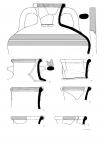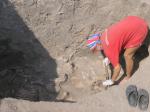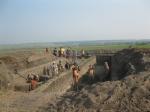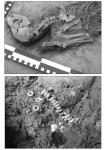Summary (English)
During the season 2010, the researchers worked on ash hill 13 uncovering 168 m2 on the excavation site.
The first task was completing the exploration of dwelling 4. Half of this object was excavated earlier, in 2008. After the end of the works, it has appeared that it was an oval pit-house measured 7.5 × 6 m and 2 m deep. An additional household pit 0.8 m deep was dug out in the southern corner within the object. The wooden frame was fixed in the six postholes. The majority of the collected artefacts consist of handmade pottery. The most noticeable find was a dog skeleton with a necklace explored yet in 2007.
Besides the dwelling, four household pits were explored in 2010. A broken clay altar together with fragments of the painted oenochoe was deposited in one of the pits.
Pit 11 measured 2.8 × 3 m and 3.4 m deep was distinguished by a huge amount of the burned clay fragments many of which had prints of a wooden frame. Those fragments covered the lower layer of the pit where a lot of Greek pottery fragments survived. It was the shreds of 13 Klazomenai amphorae and one of Miletus amphora dated by the first half of the 6th c. BC.
Pit 14 and 15 are noticeable with remnants of a sacrificing. These were the parts of cattle carcases laid on the bottom of the pits.
Two sacrificial pavements were discovered at the centre of the excavation site. One of them was constructed using stone slabs, clay cones and fragments of large wares. The base of the second pavement had two layers. The lower layer was constructed using animal bones, while the upper one was laid with stone and clay cones.
Speaking about the artefacts, the researchers note quite a high amount of the arrowheads (up to 30 specimens) found within the layers of the ash hill.
Rich and numerous materials, collected on the ash hill 13 allowed to build a chronological frame within the mid. 7th – late 6th centuries BC.
- Shelekhan Oleksandr - Institute of Archaeology, National Academy of Sciences of Ukraine
Director
- Iryna Shramko - V.N. Karazin Kharkiv National University
- Stanislav Zadnikov - V.N. Karazin Kharkiv National University
Team
- Vladislav Bondarenko - V.N. Karazin Kharkiv National University, Museum of Archeology and Ethnography of Slobidska Ukraine
- Kseniia Bondar - Taras Shevchenko National University of Kyiv
Research Body
- ДП «Слобідська археологічна служба» ОАСУ Інституту археології НАН України / State enterprise «Slobidska archeological service» of the state enterprise «Protection of the archeological survey of Ukraine» of the Institute of Archeology of the National Academy of Sciences of Ukraine
- Музей археології і етнографії Слобідської України Харківського національного університету ім. В.Н. Каразіна / Museum of archeology and ethnography of Slobidska Ukraine, V. N. Karazin Kharkiv National University






![Download [PDF]](/excavation/skins/fasti/images/results/download_sml.png)


